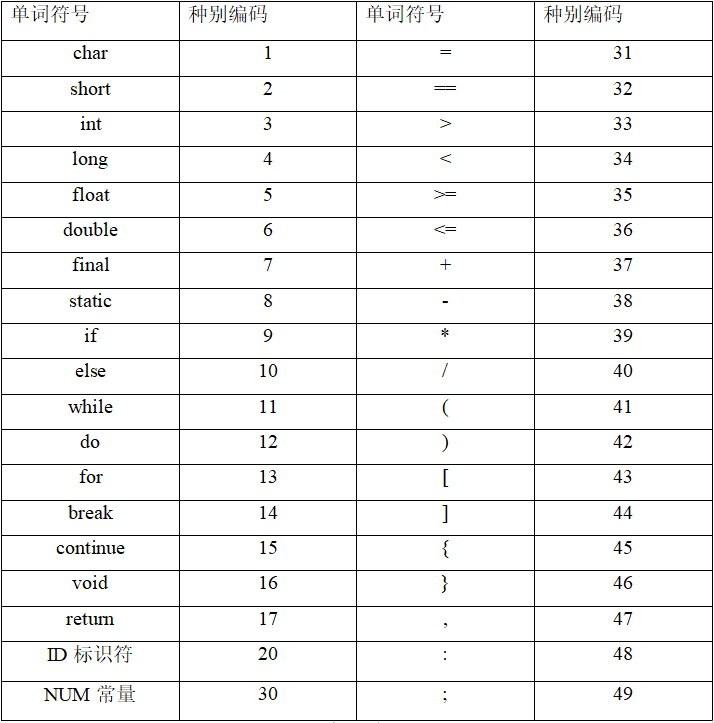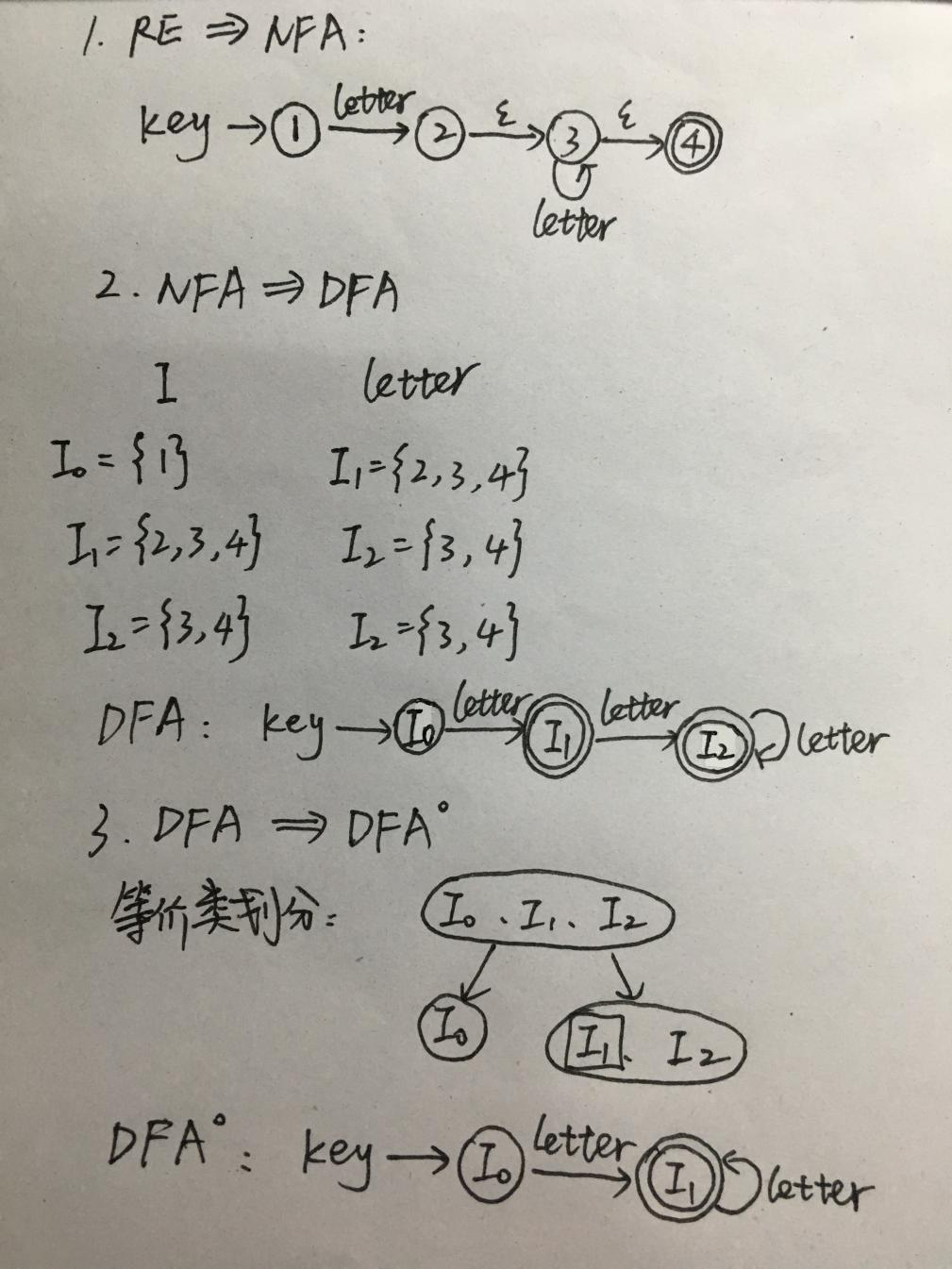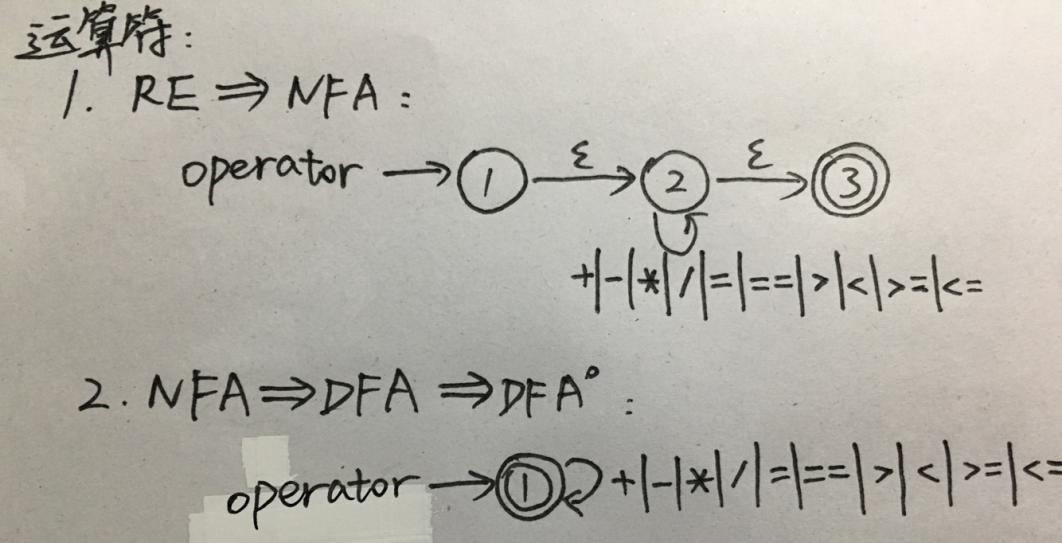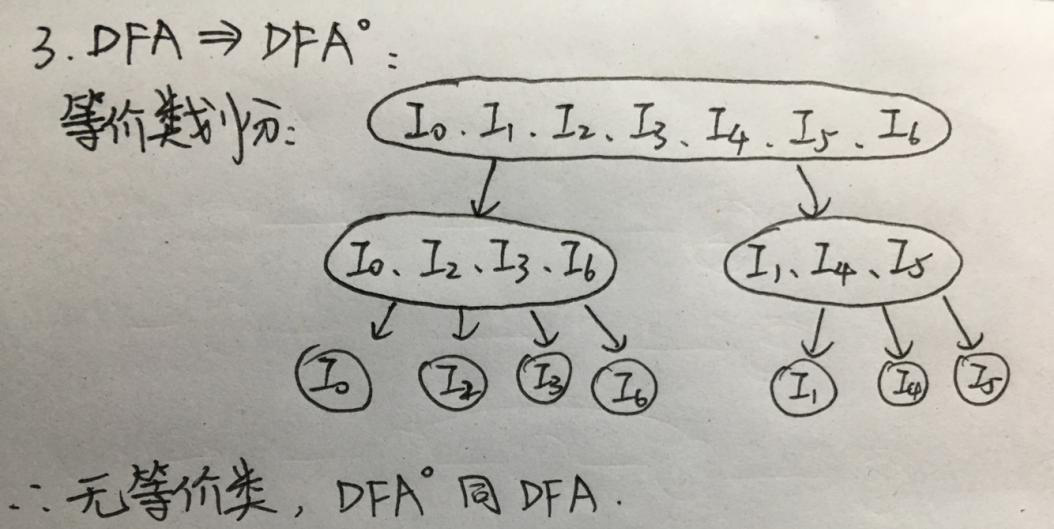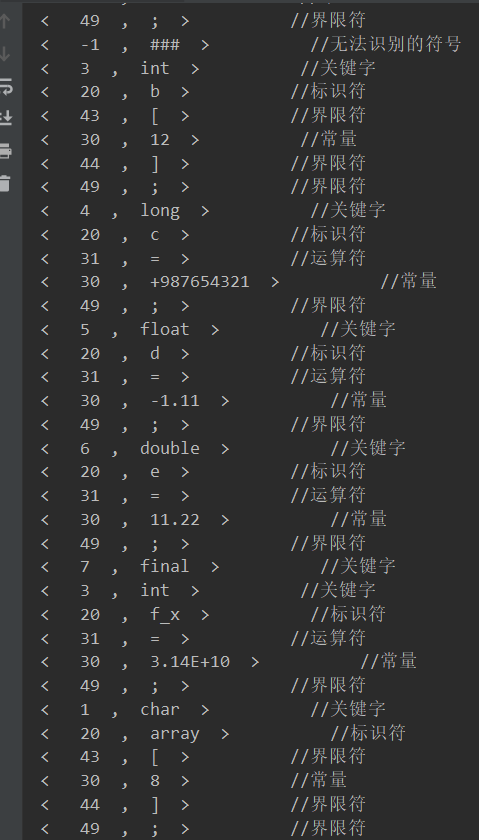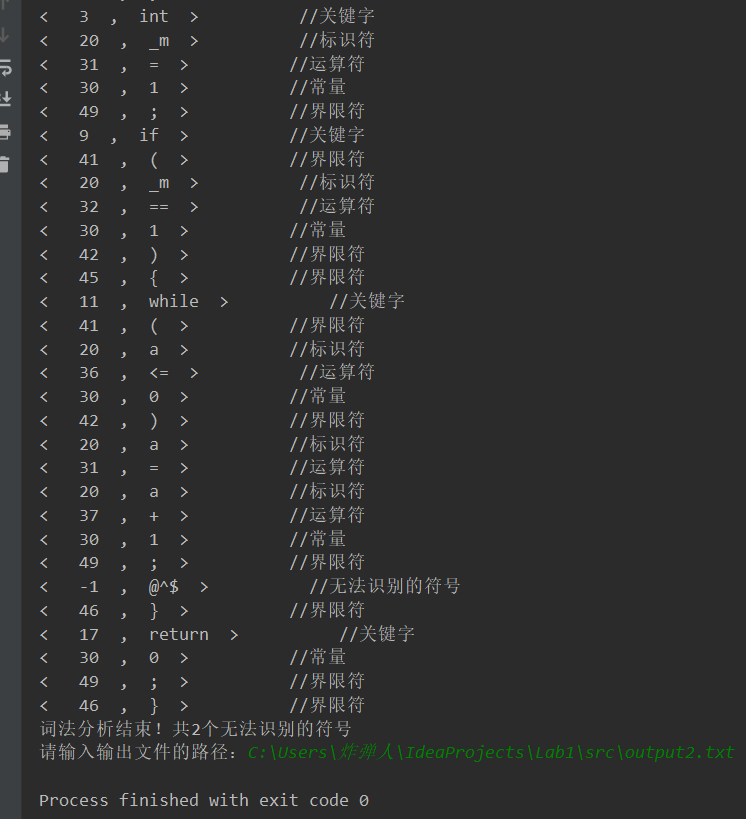词法分析器是编译原理的一个实验,本文将会详细给出实现的具体步骤,利用java进行示例讲解,源码(包含java和c++两种实现方式)可在 https://download.csdn.net/download/qq_40121502/10926516 下载。
一、 实验目的
设计、编写一个词法分析程序,加深对词法分析原理的理解。
二、 实验原理
词法分析是从左向右一个字符、一个字符地读入源程序,扫描每行源程序的符号,依据词法规则,识别单词。执行词法分析的程序称为词法分析器,将给定的程序通过词法分析器,识别出一个个单词符号。单词符号常采用统一的二元式表示:(单词种别码,单词符号自身的值),单词种别码是语法分析所需要的信息,而单词符号自身属性值是编译其他阶段需要的信息。
三、 实验内容
(1)程序利用C++或Java或其他编程语言,给出其词法的产生式(词法部分也可以用regular expression),包含数学运算表达式,赋值,函数调用,控制流语句(分支或循环),类型声明等基本元素。
(2)词法实验部分要求写出该语言的词法分析程序。要求识别出词法分析单元,给出词法单元的分类,按照不同类别填入相应的表中,表中给出词法单元在源程序中的位置。
四、 实验方法
(1)词法的产生式(或regular expression)转换成NFA
(2)NFA确定化为DFA
(3)DFA最小化
(4)根据最小化后的DFA写出词法分析程序。
(5)使用选定的编程语言写几个测试用例文件作为输入,测试词法分析程序是否正确。
五、 实验设计
(1)关键字:
“char”,“int”,“float”,“double”,“final”,“if”,“else”,“while”,“do”,“for”,“break”,“continue”,”void”,”return”
(2)运算符:=、==、>、<、>=、<=、+、-、*、/
(3)界限符:( ) [ ]{ } , : ;
(4)标识符(ID):用字母、数字、下划线的连接用来表示变量名、过程名等的单词称为标识符(不能以数字开头、不与关键字重名、不包含$、#等无法识别的字符)
(5)常量(NUM):整数、小数、浮点数。
(6)词法分析阶段通常忽略空格、制表符和换行符等。
根据以上的分类与分析,设置该语言中的单词符号及种别编码如下表:
六、状态图分析
1.关键字
本次设计中关键字有17个,分别包括:
“char”,“short”,“int”,“long”,“float”,“double”,“final”,“static”,“if”,“else”,“while”,
“do”,“for”,“break”,“continue”,“void”, “return”。
关键字都是由小写字母组成,在程序中,将17个关键字保存在一个String类型的数组中,然后做一次循环,将字符串逐个与17个关键字对比,相同则取出对应的种别码,存入ArrayList中。
关键字的正规表达式为:
key->letter( letter )*
letter->[a-z]
按照RE—>NFA—>DFA—>最小化DFA的顺序,过程如图所示:
2.运算符
本实验设计了十个运算符,分别为:=、==、>、<、>=、<=、+、-、、/
运算符表达式为:
operation -> ( = | == | > | < | >= | <= | + | – | * | / )
按照RE—>NFA—>DFA—>最小化DFA的顺序,过程如图所示:
3.界限符
本实验设计的界限符有:( ) [ ]{ } , : ;
界限符表达式为:
delimiter -> ( ( | ) | [ | ] | { | } | , | : | ; )*
从RE—>NFA—>DFA—>最小化DFA的顺序,过程如图所示:
4.标识符
用字母、数字、下划线的连接用来表示变量名、过程名等的单词称为标识符(不能以数字开头、不与关键字重名、不包含$、#等无法识别的字符)。
标识符的正规表达式为:
ID ->( letter | _ ) ( letter | digit | _ )*
letter->[a-zA-Z]
digit->[0-9]
按照RE—>NFA—>DFA—>最小化DFA的顺序,过程如图所示:
5.常量
将整数,浮点数归并后分为无符号数和有符号数。
因为有符号数,除了开始有符号外,之后的判断与无符号数是一致的。所以在这里只针对无符号数的正规表达式构造NFA和DFA。
无符号数正规表达式:
NUM -> digits op_fra op_exp
其中:
digits -> d(d)*
d -> [0-9]
op_fra-> .digits | ε
op_exp -> ( E (+|-| ε) digits) | ε
将上述表达式整合得无符号数NUM的正规表达式为:
NUM->d(d)|d(d).d(d)|d(d)(E(+|-|ε)d(d))|d(d).d(d)E(+|-|ε)d(d)
d -> [0-9]
按照RE—>NFA—>DFA—>最小化DFA的顺序,过程如图所示:
七、数据结构
(1)使用ArrayList<String>来存放从文件内读取进来的每个单词(符号)。
(2)自定义类Pair,相当于键值对,用于存放单词种别码和对应的单词,包含一个Integer类型的key和一个String类型的value。
(3)使用ArrayList<Pair>来存放词法分析的结果。
八、实现代码
1.定义关键字
首先定义了一系列关键字及其对应的种别码,用于表示词法分析的结果。
// 单词种别码, 1-17为关键字种别码
public static final int CHAR = 1;
public static final int SHORT = 2;
public static final int INT = 3;
public static final int LONG = 4;
public static final int FLOAT = 5;
public static final int DOUBLE = 6;
public static final int FINAL = 7;
public static final int STATIC = 8;
public static final int IF = 9;
public static final int ELSE = 10;
public static final int WHILE = 11;
public static final int DO = 12;
public static final int FOR = 13;
public static final int BREAK = 14;
public static final int CONTINUE = 15;
public static final int VOID = 16;
public static final int RETURN = 17;
// 20为标识符种别码
public static final int ID = 20;
// 30为常量种别码
public static final int NUM = 30;
// 31-40为运算符种别码
public static final int AS = 31; // =
public static final int EQ = 32; // ==
public static final int GT = 33; // >
public static final int LT = 34; // <
public static final int GE = 35; // >=
public static final int LE = 36; // <=
public static final int ADD = 37; // +
public static final int SUB = 38; // -
public static final int MUL = 39; // *
public static final int DIV = 40; // /
// 41-49为界限符种别码
public static final int LP = 41; // (
public static final int RP = 42; // )
public static final int LBT = 43; // [
public static final int RBT = 44; // ]
public static final int LBS = 45; // {
public static final int RBS = 46; // }
public static final int COM = 47; // ,
public static final int COL = 48; // :
public static final int SEM = 49; // ;
// -1为无法识别的字符标志码
public static final int ERROR = -1;
public static int errorNum = 0; // 记录词法分析错误的个数
2.单词分割
对于输入的代码段,进行单词的分割,需要识别判断出分割的位置,最后将拆分好的单词序列放入ArrayList<String>中保存,用于后续的词法分析。
测试文件读入内存
final String blank = " ";
final String newLine = "\n";
Scanner scanner = new Scanner(System.in);
System.out.print("请输入测试文件的路径:");
String filepath = scanner.next();
StringBuffer sb = new StringBuffer();
String fileStr = "";
try {
InputStream is = new FileInputStream(filepath);
String line; // 用来保存每行读取的内容
BufferedReader reader = new BufferedReader(new InputStreamReader(is));
line = reader.readLine(); // 读取第一行
while (line != null) {
// 如果 line 为空说明读完了
sb.append(line); // 将读到的内容添加到 buffer 中
sb.append("\n"); // 添加换行符
line = reader.readLine(); // 读取下一行
}
reader.close();
is.close();
fileStr = sb.toString();
} catch (IOException e) {
e.printStackTrace();
}
System.out.println("文件内容如下:\n" + fileStr);
单词分割
采用循环读取的方式将输入的内容进行读取分析
getFirstChar():去除字符串开头的空格和换行符,找到第一个有效字符的位置
getWord():使用正则表达式进行匹配,获取一个单词
当文件读取结束时将抛出IndexOutOfBoundsException异常,捕获这个异常,在catch块中进行后续的词法分析。
int begin = 0, end = 0; //分别表示单词的第一个和最后一个字符位置
ArrayList<String> arrayList = new ArrayList<>();
try {
do {
begin = getFirstChar(fileStr, begin);
String word = getWord(fileStr, begin);
end = begin + word.length() - 1; // 单词最后一个字符在原字符串的位置
if (word.equals("")) {
break;
}
if (!(word.equals(blank) || word.equals(newLine))) {
arrayList.add(word);
}
begin = end + 1;
} while (true);
} catch (IndexOutOfBoundsException e) {
// 文件读取结束
// 词法分析
}
/** * 去除字符串开头的空格和换行符,找到第一个有效字符的位置 * @param str 目标字符串 * @param begin 开始位置 * @return 第一个有效字符在字符串中的位置 */
public static int getFirstChar(String str, int begin) {
while (true) {
if (str.charAt(begin) != ' ' && str.charAt(begin) != '\n' ) {
return begin;
}
begin++;
}
}
/** * 获取一个单词 * @param str 目标字符串 * @param begin 查找的开始位置 * @return 单词 */
public static String getWord(String str, int begin) {
String regEx = "\\s+|\\n|\\+|-|\\*|/|=|\\(|\\)|\\[|]|\\{|}|,|:|;"; // 正则
Pattern p = Pattern.compile(regEx);
Matcher m = p.matcher(str);
int end;
if (m.find(begin)) {
end = m.start();
} else {
return "";
}
if (begin == end) {
return String.valueOf(str.charAt(begin));
}
return str.substring(begin, end);
}
3.词法分析
将分割好的单词和最开始定义的一系列关键字进行比对匹配,每个单词的分析结果由Pair类进行保存,Pair类仅代表键值对的形式,键为单词种别码,值为该单词。
Pair类定义如下:
public static class Pair {
Integer key;
String value;
Pair(Integer key, String value) {
this.key = key;
this.value = value;
}
}
词法分析函数:根据单词的长度进行分析比对
// 词法分析函数
public static ArrayList<Pair> analyse(ArrayList<String> arrayList) {
ArrayList<Pair> result = new ArrayList<>();
for (int i = 0; i < arrayList.size(); i++) {
if (arrayList.get(i).length() == 1) {
if (arrayList.get(i).equals("=")) {
// 运算符"="
if (arrayList.get(i+1).equals("=")) {
// 若后面跟的是"=",则是运算符"=="
result.add(new Pair(EQ, arrayList.get(i) + arrayList.get(++i)));
} else {
// 否则是运算符"="
result.add(new Pair(AS, arrayList.get(i)));
}
} else if (arrayList.get(i).equals(">")) {
// 运算符">"
if (arrayList.get(i+1).equals("=")) {
// 若后面跟的是"=",则是运算符">="
result.add(new Pair(GE, arrayList.get(i) + arrayList.get(++i)));
} else {
// 否则是运算符">"
result.add(new Pair(GT, arrayList.get(i)));
}
} else if (arrayList.get(i).equals("<")) {
// 运算符"<"
if (arrayList.get(i+1).equals("=")) {
// 若后面跟的是"=",则是运算符"<="
result.add(new Pair(LE, arrayList.get(i) + arrayList.get(++i)));
} else {
// 否则是运算符"<"
result.add(new Pair(LT, arrayList.get(i)));
}
} else if (arrayList.get(i).equals("+")) {
// 运算符"+"
if ((arrayList.get(i-1).equals("=") || arrayList.get(i-1).equals("("))
&& isNum(arrayList.get(i+1))) {
// 判断是否是有符号常量(正数)
result.add(new Pair(NUM, arrayList.get(i) + arrayList.get(++i)));
} else {
// 否则是运算符"+"
result.add(new Pair(ADD, arrayList.get(i)));
}
} else if (arrayList.get(i).equals("-")) {
// 运算符"-"
if ((arrayList.get(i-1).equals("=") || arrayList.get(i-1).equals("("))
&& isNum(arrayList.get(i+1))) {
// 判断是否是有符号常量(负数)
result.add(new Pair(NUM, arrayList.get(i) + arrayList.get(++i)));
} else {
// 否则是运算符"-"
result.add(new Pair(SUB, arrayList.get(i)));
}
} else if (arrayList.get(i).equals("*")) {
// 运算符"*"
result.add(new Pair(MUL, arrayList.get(i)));
} else if (arrayList.get(i).equals("/")) {
// 运算符"/"
result.add(new Pair(DIV, arrayList.get(i)));
} else if (arrayList.get(i).equals("(")) {
// 界限符"("
result.add(new Pair(LP, arrayList.get(i)));
} else if (arrayList.get(i).equals(")")) {
// 界限符")"
result.add(new Pair(RP, arrayList.get(i)));
} else if (arrayList.get(i).equals("[")) {
// 界限符"["
result.add(new Pair(LBT, arrayList.get(i)));
} else if (arrayList.get(i).equals("]")) {
// 界限符"]"
result.add(new Pair(RBT, arrayList.get(i)));
} else if (arrayList.get(i).equals("{")) {
// 界限符"{"
result.add(new Pair(LBS, arrayList.get(i)));
} else if (arrayList.get(i).equals("}")) {
// 界限符"}"
result.add(new Pair(RBS, arrayList.get(i)));
} else if (arrayList.get(i).equals(",")) {
// 界限符","
result.add(new Pair(COM, arrayList.get(i)));
} else if (arrayList.get(i).equals(":")) {
// 界限符":"
result.add(new Pair(COL, arrayList.get(i)));
} else if (arrayList.get(i).equals(";")) {
// 界限符";"
result.add(new Pair(SEM, arrayList.get(i)));
} else if (arrayList.get(i).charAt(0) >= '0' && arrayList.get(i).charAt(0) <= '9') {
// 判断是否是一位数字常量
result.add(new Pair(NUM, arrayList.get(i)));
} else if (isLetter(arrayList.get(i).charAt(0))) {
// 判断是否是一位字母标识符
result.add(new Pair(ID, arrayList.get(i)));
} else {
// 否则是无法识别的字符
result.add(new Pair(ERROR, arrayList.get(i)));
errorNum++;
}
} else if ((arrayList.get(i).charAt(0) >= '0' && arrayList.get(i).charAt(0) <= '9')
|| arrayList.get(i).charAt(0) == '.') {
// 判断是否是正确的常量
if (!isNum(arrayList.get(i))) {
// 不是常量,则是无法识别的字符
result.add(new Pair(ERROR, arrayList.get(i)));
errorNum++;
} else if ((arrayList.get(i+1).charAt(0) == '+' || arrayList.get(i+1).charAt(0) == '-')
&& isNum(arrayList.get(i+2))) {
// 判断是否是有符号的常量
result.add(new Pair(NUM, arrayList.get(i) + arrayList.get(++i) + arrayList.get(++i)));
} else {
// 否则是无符号的常量
result.add(new Pair(NUM, arrayList.get(i)));
}
} else if (isKeyID(arrayList.get(i)) != 0) {
// 判断是否为关键字
result.add(new Pair(isKeyID(arrayList.get(i)), arrayList.get(i)));
} else if (isLetter(arrayList.get(i).charAt(0)) || arrayList.get(i).charAt(0) == '_') {
// 判断是否为标识符(以字母或者下划线开头)
result.add(new Pair(ID, arrayList.get(i)));
} else {
// 否则是无法识别的单词
result.add(new Pair(ERROR, arrayList.get(i)));
errorNum++;
}
}
return result;
}
catch块内的处理部分:调用词法分析函数,输出结果到文件
ArrayList<Pair> result = analyse(arrayList);
StringBuffer outputBuffer = new StringBuffer("词法分析结果如下:\n<单词种别码,单词> //所属类别\n");
System.out.println("词法分析结果如下:\n<单词种别码,单词> //所属类别");
for (Pair pair : result) {
outputBuffer.append("< " + pair.key + " , " + pair.value + " > ");
System.out.print("< " + pair.key + " , " + pair.value + " > ");
if (pair.key > 0 && pair.key < 20) {
outputBuffer.append("//关键字\n");
System.out.println("//关键字");
} else if (pair.key == 20) {
outputBuffer.append("//标识符\n");
System.out.println("//标识符");
} else if (pair.key == 30) {
outputBuffer.append("//常量\n");
System.out.println("//常量");
} else if (pair.key > 30 && pair.key <= 40) {
outputBuffer.append("//运算符\n");
System.out.println("//运算符");
} else if (pair.key > 40 && pair.key < 50) {
outputBuffer.append("//界限符\n");
System.out.println("//界限符");
} else if (pair.key == -1) {
outputBuffer.append("//无法识别的符号\n");
System.out.println("//无法识别的符号");
}
}
outputBuffer.append("词法分析结束!共" + errorNum + "个无法识别的符号\n");
System.out.println("词法分析结束!共" + errorNum + "个无法识别的符号");
System.out.print("请输入输出文件的路径:");
String outputPath = scanner.next();
// 将StringBuffer的内容输出到文件
File outputFile = new File(outputPath);
if (outputFile.exists()) {
outputFile.delete();
}
PrintWriter writer = null;
try {
outputFile.createNewFile();
writer = new PrintWriter(new FileOutputStream(outputFile));
writer.write(outputBuffer.toString());
} catch (IOException e1) {
e1.printStackTrace();
} finally {
if (writer != null) {
writer.close();
}
}
九、执行结果
至此,词法分析器编写完成。如有问题,欢迎交流指正。
今天的文章词法分析器实现过程(java和c++实现)分享到此就结束了,感谢您的阅读。
版权声明:本文内容由互联网用户自发贡献,该文观点仅代表作者本人。本站仅提供信息存储空间服务,不拥有所有权,不承担相关法律责任。如发现本站有涉嫌侵权/违法违规的内容, 请发送邮件至 举报,一经查实,本站将立刻删除。
如需转载请保留出处:https://bianchenghao.cn/9259.html

